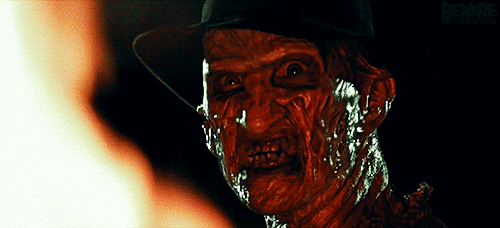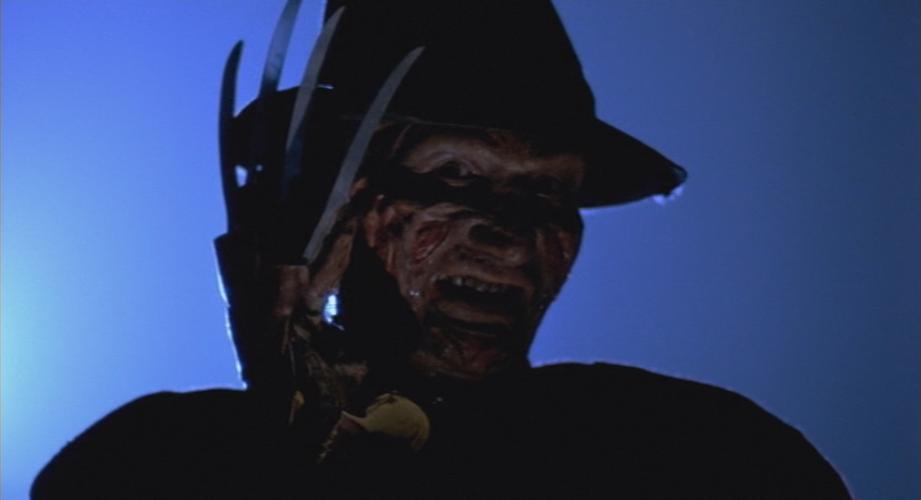Wes Craven's New Nightmare (1994)
"Miss me?" - Freddy Kreuger
By 1994, Freddy Kreuger had been dead for about 3 years. The last film had done horrible critically, but had done very very well at the box office. Yet New Line insisted that Freddy would stay dead. In the end, the most unlikely source ended up bringing him back. Wes Craven himself. Now, Wes Craven didn't really like what New Line had done to his baby. He meant it to be a self contained little film. No sequels. He begrudgingly came back to give the studio a storyline for the third film, which they took and streamlined. He absolutely hated the last three Nightmare films after he saw them eventually too. Bob Shaye called Craven I guess around 1993 to clear the air. The two, who had not seen eye to eye even during the making of the first film had let old animosities build to crescendos over the years. Wes blamed Shaye for taking his ideas and perverting them and Shaye was tired of Craven saying he hated the franchise. In the end, they forgave each other and Bob Shaye asked Craven if he had any new ideas. Craven said he didn't and would think about it. (Shaye wanted another Nightmare film.) And while Craven was thinking of how to go about bringing back a franchise that had been so twisted from its original concept and feel, he came across a great idea. Not unlike Charlie Kaufman in Adaptation., he thought of making a movie about writing the script for Nightmare 7. However, an idea is not a fully fleshed out story. And he still needed permission from those involved to bring in aspects of their private lives into the eventual script. So he had dinner with Robert Englund, who had played Freddy from the very beginning, and with Heather Langenkamp, who played Nancy in the first and third film. They discussed how the series had changed their lives and the way they lived it, and both agreed it was a good idea and that they'd be happy to be involved if the script was good. Next, Wes went to Bob Shaye and pitched the idea (throwing in a scene for Bob Shaye himself for good measure). Bob liked the idea and told Wes to get cracking on it.
The filming commenced in late 1993, with not only Heather Langenkamp, Robert Englund and Bob Shaye appearing in the film, but also Wes Craven himself and John Saxon. (Plus other cast members from other installments in the background of a funeral scene in the film.) Wes Craven wanted to explore some very controversial ideas in this film as well. Most in the front and center is if horror films negatively effect children. Remember, this was the early 1990s. Back then and in the 1980s these concerned parents groups formed to ban certain TV shows, music, and movies under the auspices that they were harmful to minors. (God forbid a parent control what their kids see instead of banning it for everyone.) Also, how did horror effect those involved with making it? These were some mighty big questions for a genre which for the past 15 years or so had been involved in little more than hacking and slashing as many people as possible. Way gone were the days of The Exorcist, The Omen, Willard, or Frankenstein which asked real questions. Horror by 1980 and until the mid-1990s was pure and simple entertainment at the basest of terms. Bloodlust. You could say that this was one of the first postmodern horror films. What we now call 'meta' films. Wes Craven would perfect this style (although it was more Kevin Williamson, the screenwriter) with Scream two years later in 1996. During the filming, the 1994 Northridge earthquake hit Los Angeles as well, which was written into the movie. (I think that sort of dates the movie, but they use it to signify the spirit of Freddy here.)
So let's talk plot. The movie has Heather Langenkamp (fictional) played by Heather Langenkamp (non-fictional) being haunted by dreams of Freddy and being harassed by a prank caller, which she's had to deal with for years. Her husband works special effects and she has a young son named Dylan who sleepwalks. Eventually her husband dies in a car accident after he falls asleep (which she dreamt about that night, but shows Freddy having caused it) and her son starts to be attacked in his sleep by Freddy. Meanwhile Heather is doing interviews and meeting with New Line about the Nightmare series. They want her to do another movie and Bob Shaye, playing himself, says Wes has a new idea and is writing a script. In the film, he explains it as, "this... entity. Whatever you want to call it. It's old, very old, and it's taken different forms in different times. The only thing that stays the same about it is what it lives for. Killing innocence one way of the other." Eventually, as Freddy becomes more powerful, it's told by Craven that an ancient evil has decided that Freddy is the best form to come back in and kill people, and that he'd been kept at bay by the former movies. Telling stories of the evil and its demise keeps it in check. He says "It can be captured sometimes. By storytellers, of all things. Every so often, they imagine a story good enough to catch its essence. Then it's held prisoner for a while. In the story. The problem comes when then the story dies. It happens a lot of different ways, the story gets too familiar, or too watered down by people trying to make it easier to sell, or it's labeled a threat to society and just plain banned. However it happens, when the story dies, the evil is set free."
It's a damned good concept, and is the main reason I love the film. This movie isn't about crazy dream sequences or teenagers trying to get adults to understand that their lives are at stake. It's not really an Elm Street film. Freddy is just the form taken by the evil here. He even looks different. He's demonic and the knives are no longer on a glove fixed over his hand. No. Here the knives grow right out of his skeletal hands. He still cracks the odd joke, but in the way he did in the first film. These aren't meant for a laugh. These are perverted taunts. They're meant to scare you. And besides the first two films, I think this is the only movie in the series that comes close to being scary in any way too. Freddy is menacing here. He's bigger, bulkier. He's Terminator Freddy. There's a child in danger here. Heather's child is played by child actor Miko Hughes. He was best known as the toddler Gage in Pet Sematary and the kid that tells Schwarzenegger that "Boys have a penis, and girls have a vagina" in Kindergarten Cop. I also remember him as that annoying kid that wanted to watch Arachnophobia in Full House. (Apparently he was in 13 episodes.) Oddly enough, his dad in real life is a special effects guy. So is Heather Langenkamp's husband in real life. And in the movie? The dad/husband is a special effects guy. (Nice going, casting!)
And who doesn't love Fran Bennett as the scary, intimidating black doctor in the film, always suspecting Langenkamp of child and self abuse. She's 100% great in the role, so convinced that Langenkamp is delusional and unfit to be a parent in her current state. Which she may actually be right about. The movie is told through Heather Langenkamp's point of view. It could all be Munchausen Syndrome and she's hallucinating and causing Munchausen by Proxy to Dylan. I'm surprised people don't bring up that idea more. It's actually more terrifying than the straight-forward idea. I'm going to guess they don't due to the scene where Dylan's babysitter is killed in the hospital by Freddy with Heather nowhere around... and people seeing her get killed in the air. If it weren't for that scene, my idea would work!
And let's not kid ourselves. Even though I love this film about as much as I do Scream, it's not as well made. It didn't age as well, it didn't reach a big audience like Scream did, and the acting isn't that great for the most part. Especially Miko's role as Dylan. His acting was better in Pet Sematary five years earlier, and he was just 3 then. And I've never been convinced Heather Langenkamp is better than a Hallmark Original Movie actress. However, Robert Englund does great playing himself, the old funny version of Freddy in one scene, and the new diabolical Freddy. Freddy isn't on screen much in this movie, it's more about the actors and film-makers, but when he is on screen it's pretty scary. And I think the focus on film-makers is why the film didn't connect with audiences, and Scream did. The meta here is based on film-makers which most people don't really care about, much less b-listers such as the ones in this film. Heck, I cared most about John friggin' Saxon, he doesn't do much in this! Scream focused on the audience as characters, so we had someone to relate to. Unless you're a filmmaker, you have no one to relate to here.
The film was released on October 14, 1994 to pretty good reviews. The critics loved the postmodernistic take on horror, and the idea of it being horror within a horror film. Even Roger Ebert, who hated the Elm Street series, gave this one a thumbs up. (No such luck for Mr. Pissy Attitude himself Gene Siskel, though. I'm not even sure he really watched the movie based on his thoughts.)
The film, which cost $8 million to make, didn't make much of an impact at the box office. Especially with it being a Nightmare film. It grossed just over $18 million. So it wasn't a bomb, but it wasn't a hit either. It is the lowest grossing film in the franchise. Now, I don't blame it all on the movie itself. The early to mid-1990s were a dead zone for horror. The genre was dead and few horror films that came out that weren't named Silence of the Lambs didn't make money. It would stay dead until Scream came on the scene in 1996. I think the movie just came out at the wrong time, sadly. It's now considered either the best or second best in the series by most fans. And it is my absolute favorite.

















